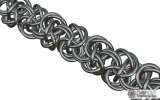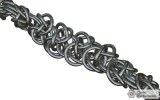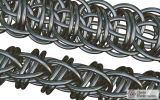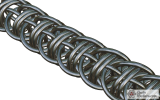What's the Difference?
The answer to the question of "What level of change to weave structure constitutes a new weave as opposed to a variant?" will vary depending on who you ask. However, it is indisputable that even minor changes in weave structure give you a weave that, while it may be similar to the root weave, is "different" from the original. Unfortunately, this often leads to confusion as to what has actually been woven. Each "What's the Difference?" article in the series will focus on a different set of similar and/or commonly confused weaves. There are many occasions where much of the confusion stems from the comparison of different images with the weaves being in multiple orientations and/or ring sizes. Renders made for the articles will be based upon similar AR's and orientation.The renders in this article are made with a wire diameter of 1.63 mm and an actual AR of 7.5. The cyan rings in these renders represent the "reinforcing" ring(s)
Fire Wyrm, Ice Wyrm, Wind Wyrm & Earth Wyrm
In this "What's the Difference?" I'll be focusing on the Full Persian reinforcement configurations that make the following weaves (from left to right):
Cellular Structure
Weave Cells
Fire & Ice Wyrms
The Fire & Ice Wyrm weaves both use what I call the "Fire Configuration". In the fire configuration, the reinforcing ring goes inside 2 opposite corners of the box cell and outside 2 opposite corners of the box cell.
Structural Note: While a box cell is not chiral (it can be mirrored through a simple rotation), Fire configuration IS chiral.
Each version of Fire Wyrm only uses a single version of the fire configuration cell.
Ice Wyrm is an alternating sequence of both versions.
Wind & Earth Wyrms
Structural Note: While wind configuration looks like 2 completely different cells, one is a rotation of the other and looking at the back instead of the front (or vice/versa). Roll either cell 90 degrees and then spin it 180 degrees and they will look identical again.
Wind Wyrm is a direct translation of the wind configuration cell.
Earth Wyrm is an alternating of the orientation of the wind configuration cell from the preceding cell.
When connected together, you wind up with the weaves commonly known as the wyrms.
From top to bottom, Fire Wyrm, Ice Wyrm, Wind Wyrm, & Earth Wyrm:
Conclusion
It is the configuration that the reinforcement rings are added and/or the orientation of the reinforced cells that differentiate the wyrms from each other.Appendix
Hybrids
Why not hybridize the weaves further? How about Firenado (Fire and Wind) or Iced Earth (Ice & Earth)?Other Applications
Fire and Wind reinforcement configurations should be applicable to any box cell at an appropriate AR:For more examples, please check out the amazing chainmailbasket.com.
Sequential Reinforcement
Sequential reinforcement is a concept that you're probably already familiar with, although you may not have heard it called by that term. While most reinforced weaves have a stable number of reinforcing rings per cell (Rhinos Snorting Drano(R1), Barrel(R2), Keg of Maker's Mark(R3) ), reinforcing rings can also be increased or decreased in a sequence (Corvus Chain, Fire Wyrm - Sequential. It is this increasing or decreasing in sequence that is considered "Sequential Reinforcement".The most recently described weave showing sequential reinforcement (and the one that sent me down this rabbit hole
Cellular Chainmaille Theory - CCT
Cellular Chainmaille Theory (CCT for short) is something that we're working on here at chainmaillers.com. It is currently a work in progress. Cell types and forms used in this article are based upon our current findings. We hope to be able to share more information with you regarding CCT in the future.Author's note:
It is our intent that these articles be living documents where additional information, corrections to any errors, and improvements will be incorporated over time. We encourage any discussion, insights, suggestions, or corrective criticism you may have on the subject presented in this article. This can be done by clicking the "Join the Discussion" button.
If you found this article useful or informative, please leave a rating.




